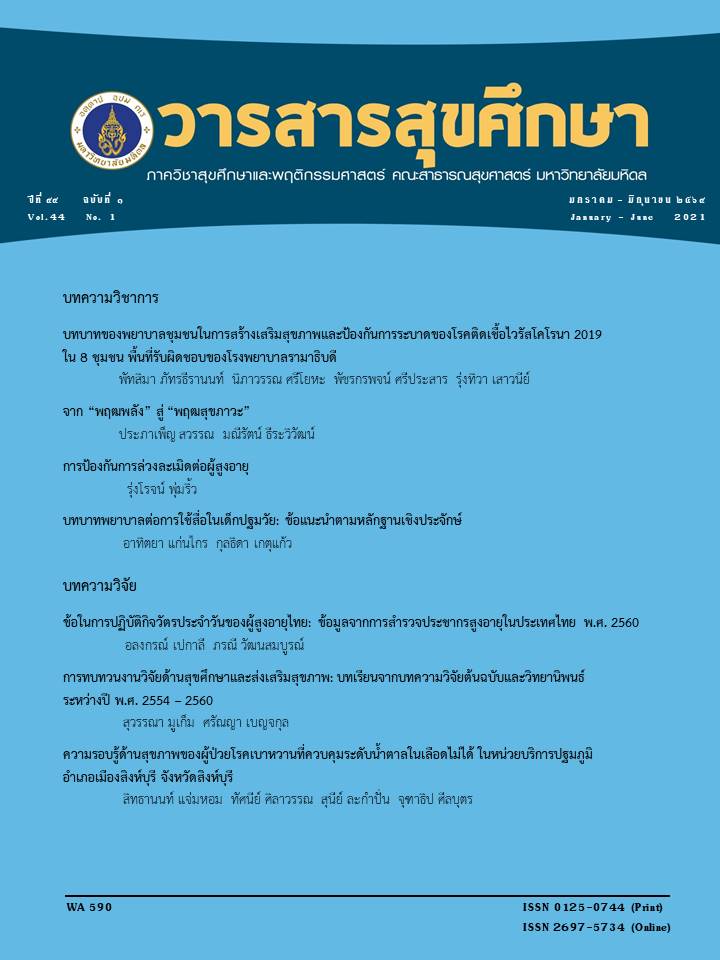The Effects of Self-Efficacy Enhancement with Social Support on Medication Adherence of Hypertensive Patients
Main Article Content
Abstract
This quasi-experimental research aimed to study the effects of perceived self-efficacy development and social support on appropriate medication taking of the hypertensive patients in Chumphon Province. The samples were 76 patients with hypertension, 38 patients in each of the experimental and the comparison groups. The experimental group participated in the perceived self-efficacy development and social support on appropriate medication taking for 10 weeks. The program consisted of the activities aiming to develop perceived self-efficacy to take medication appropriately by using lecture with the use of slide showing, practicing measuring blood pressure of their own, giving verbal persuasion, verbal admiration for encouragement, home-visit, and blood pressure surveillance by village health volunteers. For the comparison group, patients received normal services from the public health centers. Data collection was done before and after the experimentation by using an interviewed questionnaire. Data were analyzed by computing frequency, percentage, mean, standard deviation, Paired t-test and Independent t-test.
The research findings showed that after the experimentation, the experimental group had higher levels of perceived self-efficacy to take medication appropriately, outcome expectation from appropriate medication taking, and appropriate medication taking behavior than before the experimentation and the comparison group, and a significantly lower level of blood pressure was found compared to before the experimentation and the comparison group (p<0.005). This findings showed that the program on perceived self-efficacy development and social support for appropriate medication taking was effective and can be applied in taking care and promoting patients with hypertension or with other chronic diseases who have to have to take medication continuously by using activities in accordance with the context of the health service centers as well as the condition of patients’ problems about medication taking.
Article Details
References
World Health Organization. Hypertension 2019 [Internet]. [cited 2019 March 13]. Available from: https://www.who.int/health-topics/hypertension/
World Hypertension League Mortality in patients with hypertension 2019 [Internet]. [cited 2019 March 13]. Available from: https://www.whleague.org/
สำนักโรคไม่ติดต่อ กรมควบคุมโรค กระทรวงสาธารณสุข. สถานการณ์ปัจจุบันกลุ่มโรคไม่ ติดต่อ [อินเทอร์เน็ต]. 2561 [เข้าถึงเมื่อ 10 มีนาคม 2562]. เข้าถึงได้จากhttp://www.thaincd.com/2016/mission1
สำนักนโยบายและยุทธศาสตร์.อัตราตายด้วยโรคหลอดเลือดสมอง [อินเทอร์เน็ต]. 2561 [เข้าถึงเมื่อ 10 มีนาคม 2562]. เข้าถึงได้จากhttp://spd.moph.go.th/new_bps/43file_version2.3
กลุ่มงานพัฒนายุทธศาสตร์สาธารณสุข สำนักงานสาธารณสุขจังหวัดชุมพร. 10 อันดับแรกของสาเหตุอัตราป่วยของผู้ป่วยนอกจังหวัดชุมพร [อินเทอร์เน็ต]. 2561 [เข้าถึง เมื่อ 10 มีนาคม 2562]. เข้าถึงได้จาก: http://www.cmpo.moph.go.th/cmp3/index.php/
International Society of Hypertension ISH Global Hypertension Practice Guidelines 2019 [Internet]. [cited 2019 June 29]. Available from: https://ish-world.com/index.htm
สำนักงานปลัดกระทรวงสาธารณสุข. อัตราป่วยด้วยโรคความดันโลหิตสูงใน ประเทศไทย [อินเทอร์เน็ต]. 2561 [เข้าถึง เมื่อ 10 มีนาคม 2562]. เข้าถึงได้จาก:https://ops.moph.go.th/public/index.php/hdcservice
ณัฐนันท์ คำพิริยะพงศ์ และศิริพันธุ์ สาสัตย์. ผลของโปรแกรมความเชื่อด้านสุขภาพต่อพฤติกรรม การใช้ยาในผู้สูงอายุโรคความดันโลหิตสูง. วารสารแพทย์นาวี 2560; 44(3): 67-83.
Bandura A. Social Learning theory. Englewood Cliffs, NJ: Prentice-Hall; 1997.
Evans Rj. Albert Bandura: The man and his ideas – A dialogue. New York:Praeger; 1989.
Wayne W. Daniel. Biostatistics: A foundation of analysis in health science. (7th ed). New York: John Wiley & Sons; 1999.
สุนิดา สดากร, วรนุช แสงเจริญ, โพยม วงศ์ภูวรักษา และสงวน ลือเกียรติบัณฑิต. ผลของการให้คำแนะนำโดยเภสัชกรในผู้ป่วยโรคเบาหวานชนิดที่ 2. วารสารเภสัชศาสตร์อีสาน 2557; 9 (ฉบับพิเศษ): 116-121.
นันทิกานต์ หวังจิ, อุมาพร ปุญญโสพรรณ และไหมไทย ศรีแก้ว. ผลของโปรแกรมการปรับเปลี่ยนพฤติกรรมต่อความร่วมมือในการรักษาด้วยยาและระดับความดันโลหิตในผู้สูงอายุมุสลิมที่ควบคุมโรคความดันโลหิตสูงไม่ได้. 34th the national graduate research conference 2558; 34: 835-846.
ทีปภา แจ่มกระจ่าง, ณัฐสุรางค์ บุญจันทร์ และจิรวรรณ มาลา. ผลของโปรแกรมการส่งเสริมสมรรถนะแห่งตนและการสนับสนุนทางสังคมต่อความร่วมมือในการรับประทานยาและความดันโลหิตของผู้สูงอำยุโรคความดันโลหิตสูงในชุมชน. วารสารพยาบาลทหารบก 2560; 18:270-279.
จุฑารัตน์ ศิริพัฒน์, สุทธีพร มูลศาสตร์ และฉันทนา จันทวงศ์. ประสิทธิผลของโปรแกรมป้องกันโรคความดันโลหิตสูงในบุคคลที่เสี่ยงต่อโรคความดันโลหิตสูง. วารสารการพยาบาลและการดูแลสุขภาพ 2562;37(1):42-51.
สมพงษ์ หามวงค์ และพรรณี บัญชรหัตถกิจ. โปรแกรมสุขศึกษาโดยประยุกต์ใช้ทฤษฎีความสามารถแห่งตนร่วมกับแรงสนับสนุนทางสังคมในผู้ป่วยเบาหวานชนิดที่ 2. ศรีนครินทร์เวชสาร 2556;28(4):451-460.
นวพร วุฒิธรรม, รัตนา ช้อนทอง และชุติญา สมประดิษฐ. ผลของการเสริมสร้างการรับรู้สมรรถนะแห่งตนต่อการควบคุมระดับความดันโลหิต ในกลุ่มเสี่ยงโรคความดันโลหิตสูง. วารสารพยาบาลทหารบก 2563;21(1):309-318.
นิภานันท์ สุขสวัสดิ, อารยา ปรานประวิตร และสาโรจน์ เพชรมณี. ผลของโปรแกรมสุขศึกษาโดยประยุกต์ใช้ทฤษฎีความสามารถแห่งตนร่วมกับแรงสนับสนุนทางสังคมเพื่อการดูแลตนเองในผู้สูงอายุที่เป็นโรคเบาหวานของโรงพยาบาลส่งเสริมสุขภาพ ตำบลท่าสะท้อน อำเภอพุนพิน จังหวัดสุราษฎร์ธานี. วารสารการพัฒนาสุขภาพชุมชน มหาวิทยาลัยขอนแก่น 2559;4(1):49-65.
สุปรียา ตันสกุล. ทฤษฎีและโมเดลการประยุกต์ใช้ในงานสุขศึกษาและพฤติกรรมศาสตร์. (ฉบับปรับปรุง พิมพ์ครั้งที่ 2). กรุงเทพฯ: ยุทธรินทร์การพิมพ์; 2548.
อรวรรณ มุงวงษา, มณีรัตน์ ธีระวิวัฒน์, สุปรียา ตันสกุล และนิรัตน์ อิมามี. โปรแกรมการรับรู้ความสามารถตนเองในการบริโภคอาหารเพื่อควบคุมระดับน้ำตาลในเลือดของผู้ป่วยเบาหวานชนิดที่ 2 จังหวัดนครปฐม. วารสารกรมการแพทย์ 2560;42(5):62-70.
เรืองศรี ศรีสวนจิก และศิริมาศ ปิยะวัฒนพงศ์. ผลของโปรแกรมส่งเสริมการรับรู้ความสามารถของตนเองร่วมกับการสนับสนุนของครอบครัวต่อพฤติกรรมการดูแลเท้าของผู้สูงอายุโรคเบาหวาน ชนิดที่ 2 กลุ่มเสี่ยงสูงต่อการเกิดแผลที่เท้า. วารสารการพยาบาลและการดูแลสุขภาพ 2557;34 (1):105-114.


